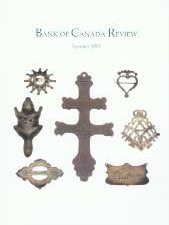Summer 2001

|
The Changing Effects of Energy-Price Shocks on Economic Activity and Inflation by Gerald Stuber
Innovation and Competition in Canadian Equity Markets
Analyzing the Monetary Aggregates
See also: Tables A1, A2, and Notes to the Tables |
Cover: Trade Silver
Traders in early North America offered a wide variety of merchandise to the native peoples in exchange for their furs. This included brass and glass beads, blankets, knives, and guns, as well as numerous items for domestic use. Among the most desirable of these items were silver ornaments or trade silver, examples of which are pictured on the cover.
From the late 17th to early 19th century, large quantities of trade silver were fashioned by both domestic and European manufacturers and were used mainly by traders along the East Coast, around the Great Lakes, and along the Mississippi. Silversmiths in centres such as Albany, Buffalo, Detroit, Montréal, and Quebec City used circulating coins such as the Spanish colonial 8-real piece to produce ornaments in a broad range of shapes and sizes. Some designs were taken from the cultural symbols of the native peoples; animals such as the turtle figured in creation myths, while round or crescent moon-like brooches and gorgets symbolized power. Other motifs were European in origin, such as crowned hearts and shapes modelled on the Masonic crest, but these were quickly accepted and, in some cases, given cultural relevance.
Paintings from this period attest to the popularity of these trade goods. First Peoples are often depicted wearing a profusion of trade silver in the form of brooches, hair ornaments, headbands, earrings, nose bobs, and bands on the upper arm, wrist, neck, and fingers. Some historians have attributed this popularity to the value of silver as a status symbol, others to the belief among some tribes that the reflective quality of silver could ward off the influence of evil spirits and enhance the power of positive natural forces like the sun.
The value of trade silver in barter varied with the size and detail of the item. Sir William Johnson, British Superintendent of Indian Affairs in colonial New York in the mid-18th century, indicated that a well-made arm band or large hair plate was worth three beaver skins, whereas a large cross was worth only one beaver and a brooch one racoon.
The objects featured on the cover range in size from 1 to 2.5 inches in width. They form part of the National Currency Collection, Bank of Canada.
Photography by James Zagon.




